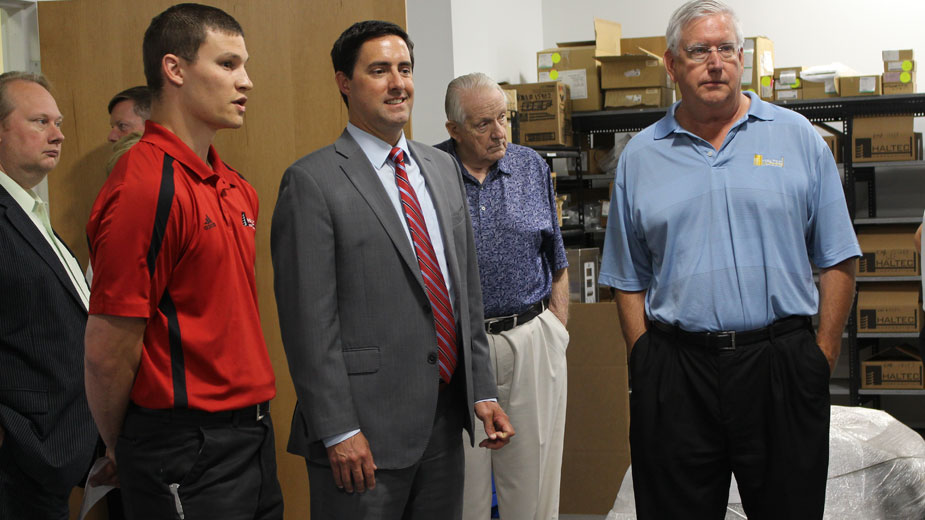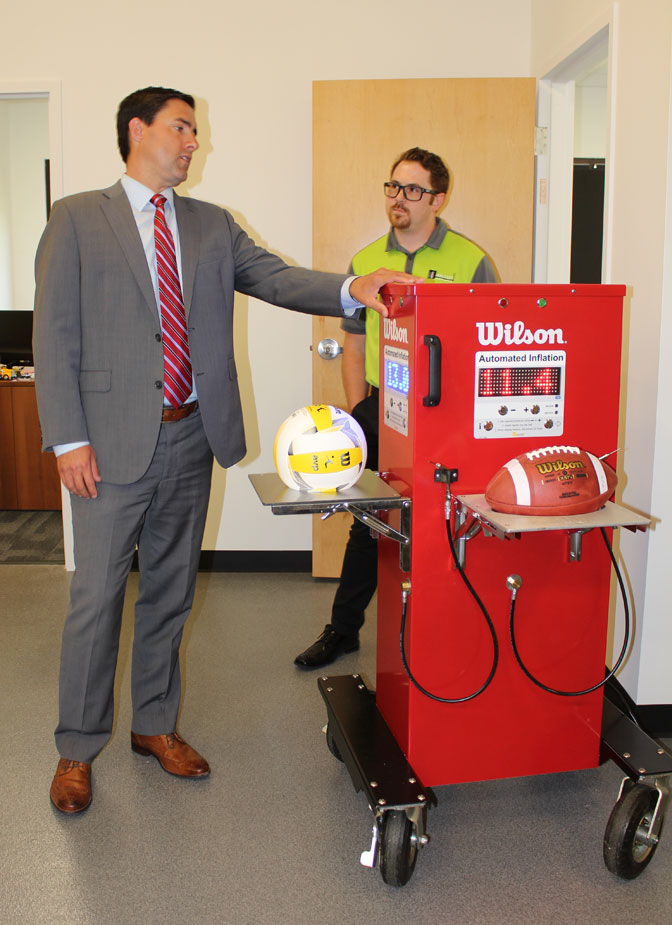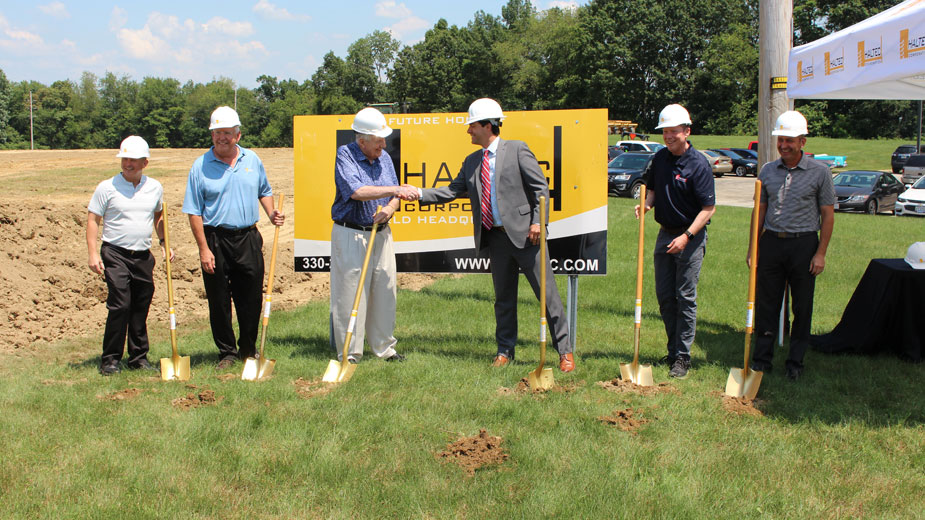Haltec Welcomes LaRose as It Launches $8M Expansion
LEETONIA, Ohio — In a ground-breaking ceremony Wednesday afternoon, Haltec Corp. kicked off the start to a 59,000-square-foot expansion at its headquarters in the World Trade Park here.
Though the ground for the 10-acre plot was already technically broken – earth-moving equipment were busy bulldozing the land near the ceremony – company executives, economic development representatives and elected officials applauded the event. Among them was Ohio Secretary of State Frank LaRose, who issued a proclamation to company ownership.
“Entrepreneurship and small business is the backbone of Ohio’s economy,” LaRose said. “We love our Fortune 500 companies, that’s awesome, but it’s companies like this that are really making a difference in Ohio.”
Located across the street from Haltec’s main building, the expansion will house the company’s manufacturing and assembly operations, said its president, Tom Moyer. A third phase will see construction of a finished goods warehouse. When complete, the project is expected to total $8 million to $10 million, he said. Hively Construction Co. Inc., Canfield, is the contractor for the project.
In January, Haltec moved its main office to the World Trade Park after outgrowing its 45,000-square-foot space in Salem where it did all of its manufacturing and distribution, Moyer said. After the expansion is complete, the Salem location will be used for distribution for the time being and Haltec has no intention of closing it down, he said.
“We’re trying to repurpose it,” he says. “It will certainly be a distribution point for a couple of years, but we do have some ideas of what we might be able to repurpose the building into.”
As a manufacturer of tire valves, the advent of tire-pressure monitoring systems inspired Haltec to consider technology and the Internet of Things as a means to expand its products and services, Moyer said. In 2007, when the federal government mandated all passenger cars have tire-pressure monitoring systems, “we could see down the road that it was going to come to trucks and mining equipment,” he said.
Now Haltec offers a line of tire-management software that uses automatic tire inflators with Bluetooth and ZigBee capabilities, which can report analytics to the user, including tire pressure and remaining tire tread, he said.
“The truck driver or fleet manager can get instant access to that report,” which typically would have taken two weeks after all the measurements are taken and calculated, he says. Developing the technology is a main reason why Haltec moved to its current Leetonia site.
“This whole building is about building intelligence into our products and our customer’s products to make them safer, reliable and interactive,” Moyer says. “This will allow that product – whether it’s a self-driving car or a self-driving mine vehicle – to give information about tire pressure, tire condition, tire temperature and be interactive with the end user.”
Haltec has since repurposed that technology into inflation for footballs and basketballs, he says. The company has an agreement with Wilson Sporting Goods Co. to provide the company air inflation systems for its football manufacturing operations in Ada, Ohio. Haltec also developed on-field inflation equipment for the NFL.
Moyer expects the expansion to be completed this fall and operations to begin in the spring of 2020. The expansion will allow the company to lay out the production lines in a more organized manner and increase manufacturing efficiency, as well as add to its machining equipment. Moyer expects to hire 30 to 40 employees over the next three to four years, “but we’re optimistic that we can do even better,” he says. Haltec employs 130 in Leetonia, 25 at a Florida company it owns, and “we recently just made an acquisition in Ireland.”
He also expects to expand Haltec’s service footprint, which currently exports up to 30% of its sales to 130 different countries, he said. Haltec has enjoyed “three good years of growth,” about 15% to 20% annually, he said, and is on track for a record year this year.
Moyer led Secretary of State LaRose on a guided tour through the company’s headquarters. The visit was part of a day-long tour of the Mahoning Valley, starting with a Youngstown/Warren Regional Chamber Lattes and Legislators event at the Soap Gallery in Youngstown, a visit to the Trumbull County Board of Elections and finishing at the Columbiana County Board of Elections.

During the morning events, LaRose spoke with economic development officials, small-business owners and Youngstown Mayor Jamael Tito Brown about how his office can assist small businesses, he said.
“Our office is the front door for any new business” in Ohio, LaRose said. His office assists with articles of incorporation, Uniform Commercial Code, or UCC filings, and notary commissions. He touted the cost of starting a new business in Ohio being $99, “the lowest cost of any state in the Midwest,” he said.
“Plus, we offer online service. It happens very quickly,” he said. “In most cases, it only takes four or five hours to get notification back that your business is going to be started here in Ohio.”
LaRose stressed the importance of engaging with minority and women-owned businesses, and working to ensure anything that is available to those business owners is immediately accessible upon receipt of their articles of incorporation so they don’t have to search for them, he said.
“We want to make sure that Ohio is a place where people can start and grow a business,” he said, “and we really want to focus in our office on making sure that Ohio’s minority business owners, women business owners, veterans and disabled business owners are given the services that they need when they get ready to start their business.”

LaRose’s office also works to help prevent business identity theft, which has emerged over the last few years, he said. In its 2019 Data Breach Investigations Report, Verizon reports that 43% of cyberattacks target small businesses.
“We’re working to make sure people can protect the integrity of their business by registering their email address online with us so they can get notified if anything changes about the status of their business,” LaRose said, “and protect their good name that they’ve worked so hard to build.”
While at the Trumbull County Board of Elections, LaRose discussed the details of the security directive issued in June. In an effort to ensure the security of the 2020 presidential election, LaRose’s office assigned a task list to the boards of elections in Ohio’s 88 counties that must be completed by the end of January 2020. The task list isn’t easy, he acknowledged, but when completed “we’re going to be able to say that Ohio is the best prepared state in the nation to protect against cyberattack and make sure that we maintain the integrity of our elections process,” he said.
The state is leveraging $12 million in federal funding that will be available to county boards of elections to be used to make needed cybersecurity adjustments, LaRose said. IT experts from the Secretary of State’s office are available to work with boards of elections to employ such measures.
“So this is something where we’re not just sort of telling them what to do and letting them figure it out on their own,” he said. “We’re working with our county boards of elections, we’re taking very proactive steps that address not only the technology – the hardware and the software – but also the human component of this.
Efforts include proper training, background checking and vetting of elections workers, and ongoing testing and training against cyberattacks and phishing emails, he said. Other initiatives include requiring all boards of elections websites and emails to use a .gov or .us domain and monitoring internet servers for intrusions.
LaRose also addressed the $115 million the state invested last year in new voting machines. While they are available to all 88 counties, some are taking advantage of the new machines this year, while others will wait until after the 2020 presidential election, he said.
Trumbull County is “fielding a new generation of voting machines, and they’re very excited about that,” he said. Voters shouldn’t be intimidated by the machines, which LaRose said are intuitive and easy to use. Poll workers will help with the process, and voters can visit their Board of Elections ahead of time to see how the new machines work, he said.
Like before, the new voting machines are never connected to the internet, nor is the server that tabulates the results, he said, so “every Ohioan should be confident that when their vote is cast that it’s going to be accurately counted.
“Nobody should sit out an election, nobody should skip an election because of fears about foreign engagement or cyberattack or whatever else,” he continued. “We run fair and honest elections here in the state of Ohio.”
Regarding the proposal to change the date of Ohio’s primary election to March 17, St. Patrick’s Day, LaRose said he doesn’t believe the change would impact voters’ ability to vote. In a letter dated July 3, nine Democratic Ohio House representatives from Cuyahoga County expressed concerns that St. Patrick’s Day celebrations would make it difficult for voters to get to the polls.
“We know our constituents want to do their civic duty and vote, but they should not be forced to sacrifice their traditions with friends and family because of an ill-conceived change to the election calendar,” they wrote. “Nor should those who don’t celebrate be blocked from their polling places by festivities that may close roads and polling places.”
LaRose cited the 28 days of early voting available at the county boards of elections, as well as the no-fault absentee voting that allows anyone to cast an absentee ballot. Those who choose to wait until election day have from 6:30 a.m. to 7:30 p.m. to vote, “so there are a lot of opportunities to cast your ballot,” he said.
“We’re one of only five states in the nation that has Sunday voting; one of only 20 states in the nation that has weekend voting at all,” he said. “And again, with 6:30 a.m. to 7:30 p.m., for example, if they do hold the election on St. Patrick’s Day, you’ve got a lot of opportunities to vote before you go out and have your favorite pint.”
Stephanie Penrose, director of the Trumbull County Board of Elections, agrees that such a change shouldn’t affect turnout that much, and “if anything might drive more early voting,” she said. In the 2016 presidential primary, just 14% of the 64,653 ballots cast were absentee, she said.
She acknowledged that issues could arise with polling locations inside of Catholic Churches, which would need to be temporarily relocated during religious observances of the holiday.
“You’d have to inform the voters in that precinct that you were moving that location, even if it’s temporarily,” Penrose said. “So, it could get costly as well with postage, paper, envelopes and the like.”
Pictured above: On hand for the ground breaking were (from left) Frank Bezon, chief financial officer, Haltec; Tom Moyer, Haltec president; Ed Russell, Haltec board chairman; Ohio Secretary of State Frank LaRose; Mike Russell, vice president of information technology; Brian Horne, Hively Construction.
Copyright 2024 The Business Journal, Youngstown, Ohio.



